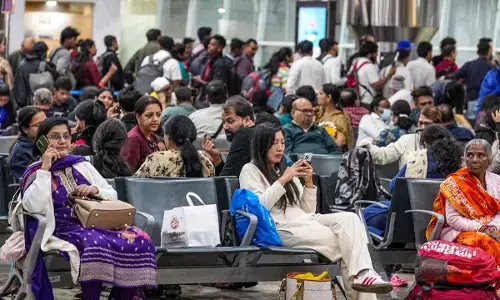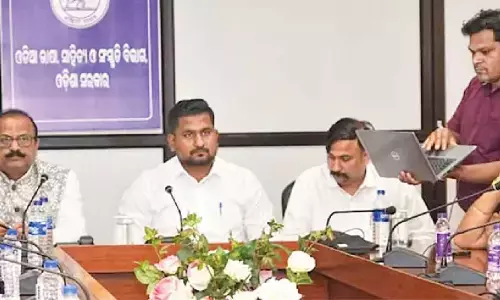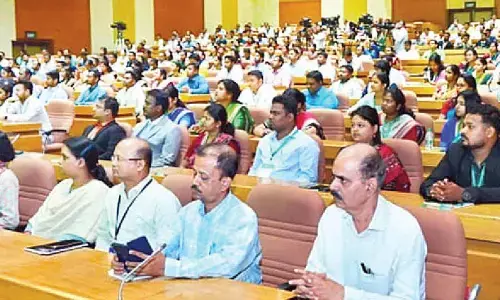Green initiatives for disaster mitigation

In June this year, Assam witnessed devastating floods causing inundation of large tracts of lands in 32 districts, damage to property, infrastructure and public utilities and disruption of livelihood sources of 45 lakh people and tragic loss of 110 human lives.
In June this year, Assam witnessed devastating floods causing inundation of large tracts of lands in 32 districts, damage to property, infrastructure and public utilities and disruption of livelihood sources of 45 lakh people and tragic loss of 110 human lives. Andhra Pradesh, Telangana, Maharashtra, Gujarat and now Kerala followed the queue with disastrous consequences.
Floods are recurrent phenomena and it is a matter of serious concern to note that the frequency and intensity of floods and related damages are showing an increasing trend in the country. According to the data furnished in Rajya Sabha, floods caused 1,808 human deaths and economic loss of Rs 95,000 crore (estimated) in a single year, 2018.
Our country is one of the most disaster-prone countries in the world due to adverse geo-climatic conditions and unfavourable topographic features. It is estimated that 46 million hectares of land area is flood-prone and 5700 km of the coast line is vulnerable to cyclones. As many as 5,161 urban habitations (cities/towns) are susceptible to floods.
The heavy concentration of rainfall within a span of three months period in most parts of the country becomes a reason for massive runoff and severe floods. Non-availability of moisture over large part of the year makes 68 per cent of the land mass vulnerable to drought. Long coast line of about 8,000 km puts several parts of the country under the radar of severe threat of cyclonic damages and tsunami effects.
Over a period of time, the government machinery has perfected the delivery system of efficient relief measures and timely execution of temporary rehabilitation works in this regard. But as for long-term preventive and mitigation measures are concerned, a lot of efforts are in progress, but still it is a long way to go. It is time now to look for nature-based solutions in the form of massive efforts in protecting forest ecosystems, their restoration and conservation together large-scale afforestation interventions to protect and shield from the hazards of natural disasters.
Forests and disaster mitigation
Forests and vegetation help to increase soil stability, improve water retention, increase water infiltration and regulate run-offs with resultant positive effect on hydrological cycle which aids in mitigating the damages from floods, landslides and drought. Deforestation is found to be one of the key factors responsible for frequent occurrences of floods and related damages. A study by IIT, Kharagpur (2017), concludes that that the loss of forest cover can make the ecosystems, human habitations and various natural resources more vulnerable to changing climatic conditions in the form of extreme weather events such as the damage from the floods and other related natural disasters. Afforestation, ecosystem maintenance and planting trees around the river and catchment areas can reduce the intensity of floods by 20 per cent (BBC). Coastal shelter belt plantations are found to reduce storm surge, by lessening the energy of waves, and minimise the damage caused by potential coastal flooding. Mangrove forests are proved to provide a barrier or buffer between the land and the sea and to protect coastal zones against potentially devastating ocean events including tsunamis.
Research studies of MS Swaminathan Foundation confirmed that when the tsunami struck India's southern state of Tamil Nadu on 26 December, 2004 areas in Pichavaram and Muthupet with dense mangroves suffered fewer human casualties and less damage to property compared to areas without mangroves.
Forestry for protective functions
Historically, the Indian forestry had a leading place in tropical silviculture, forest conservation and forest management in the world. Scientific forestry which began about 160 years ago had focussed on production aspects especially on timber and commercial products in accordance with the mandate of colonial rule. However there were some efforts to take up afforestation works along river banks and reclamation of ravines and other eroded areas in Himalayan region. Protective functions got some place of importance with the introduction of forestry works for soil conservation immediately after independence.
Though the production forestry continued to be main agenda of forestry until 1980s, there were some efforts in different parts of the country to take up afforestation works for ameliorating environment and preventing natural disasters. The Tamil Nadu forest department did a pioneering work in 1960s by undertaking shelter belt plantations along the coast to protect from cyclonic hazards. In the late seventies, post Diviseema cyclone (1977), the Andhra Pradesh forest department initiated coastal shelter belt plantations of Casuarina to mitigate the effects of cyclones with successful outcomes. Odisha, West Bengal and other States also took up large-scale coastal shelter belt plantations in their states.
With the advent of National Forest Policy, 1988, the role of the forestry now mainly rests on environmental stability and socio-economic benefits to the local people. This policy gives a good support to focus on protective functions of the forest which is the need of the hour. However, there are some persuasive efforts from some plantation experts and entrepreneurs to influence policy reforms so as to give way for more thrust on timber production and private participation in forestry which is likely to deflect the focus from the more important and well-needed protective role of forestry. The main reason quoted in support of their argument is raising of imports of wood and wood products and its burden on exchequer. This contention is not maintainable as the total value of imports on wood and wood products constitutes miniscule part (0.05 percent) of aggregate import bill of all items put together (2021). Moreover, the forestry practices of Malaysia and New Zealand which are shown as examples do not find rationale to replicate in our country as their per capita forest area is 13 and 30 times more respectively than ours.
The solution here is to support and aggressively promote agro forestry which is already in good progression. It is, therefore, necessary to keep protective functions, flow of various other ecosystem services including socio-economic benefits to local communities and forest dwellers at the centre of forestry in our country.
The way forward
Forestry intervention for mitigation of natural disasters has become more appropriate than ever before in view of the increasing trend of occurrence natural calamities and associated damages on one hand and the demonstration of its effectiveness on the other. Forest Service has to play a proactive role in designing and executing appropriate strategies to address these issues in a comprehensive manner. Protecting the catchments of rivers and water bodies by way of conserving forest ecosystems, rehabilitating degraded areas and afforestation needs a preferential place in forestry.
Mangrove forests should get priority of strict protection from the problems of exploitation, diversion and pollution. About 41 per cent of total mangrove cover of 4,992 Sq Km (ISFR, 2021) requires immediate restoration through effective people's participation. An integrated programme of afforestation/forest development through massive shelter belt plantations and restoration of mangroves with people's participation covering the entire coast line of 8,000 km will create a powerful bio-shield to mitigate the hazards from the natural disasters. Launching of such programme deserves a favourable consideration by the government of the day. It would become a 'Great Green Wall of India' to safeguard the coastal areas and its people effectively from the wrath natural disasters in an efficient way.
(Writer is Former Principal Chief Conservator of Forest & Head of Forest Force, Andhra Pradesh. The views expressed are personal)


















